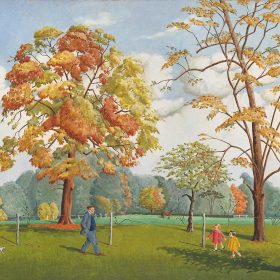
Ula Paine was a painter of rare talents and originality whose work remains largely in the dark. Her early precocity was nurtured within a liberated, artistic household: her grandfather was the Victorian painter George Hilditch, but art school and the hard realities of professional necessity crushed her vitality and she had to wait until after the War for her métier to be allowed to flourish. London’s leafy suburbs and parks, its quiet corners, gardens and canals, peopled by a reemergent middleclass gave her her subject and a pitch perfect atmosphere of ‘other’. The optimism of The Festival of Britain in 1951, the expansion of art publishing, magazines, the homemaking impulse, aspirational interior design, television and advertising all created a milieu in which her beautifully composed urban landscape and poised, enigmatic still life found their place. For Paine, trees are as much the landmarks of the urban as the architecture; trees judiciously planted, listed and looked after made a resurgent London a place of calm, as much survivors of The Blitz as the people walking their dogs and wheeling their kids in prams in the sunshine and shade. She lived a long and productive life and her show at London’s Grosvenor Gallery in 1991 at eightyone earned her an interview with Micheal Parkinson: a character; feisty, a survivor. But we must look at Paine’s work to recognise her talent. Guy Peploe